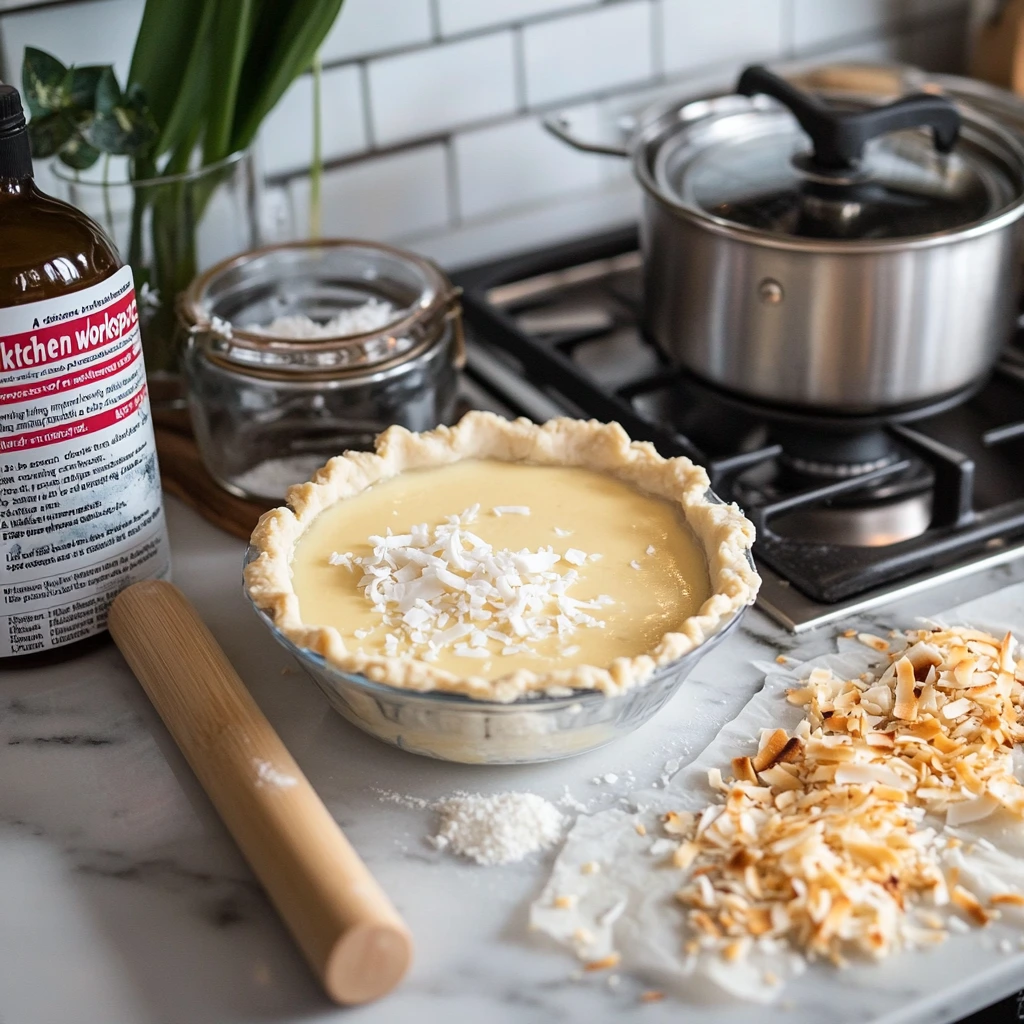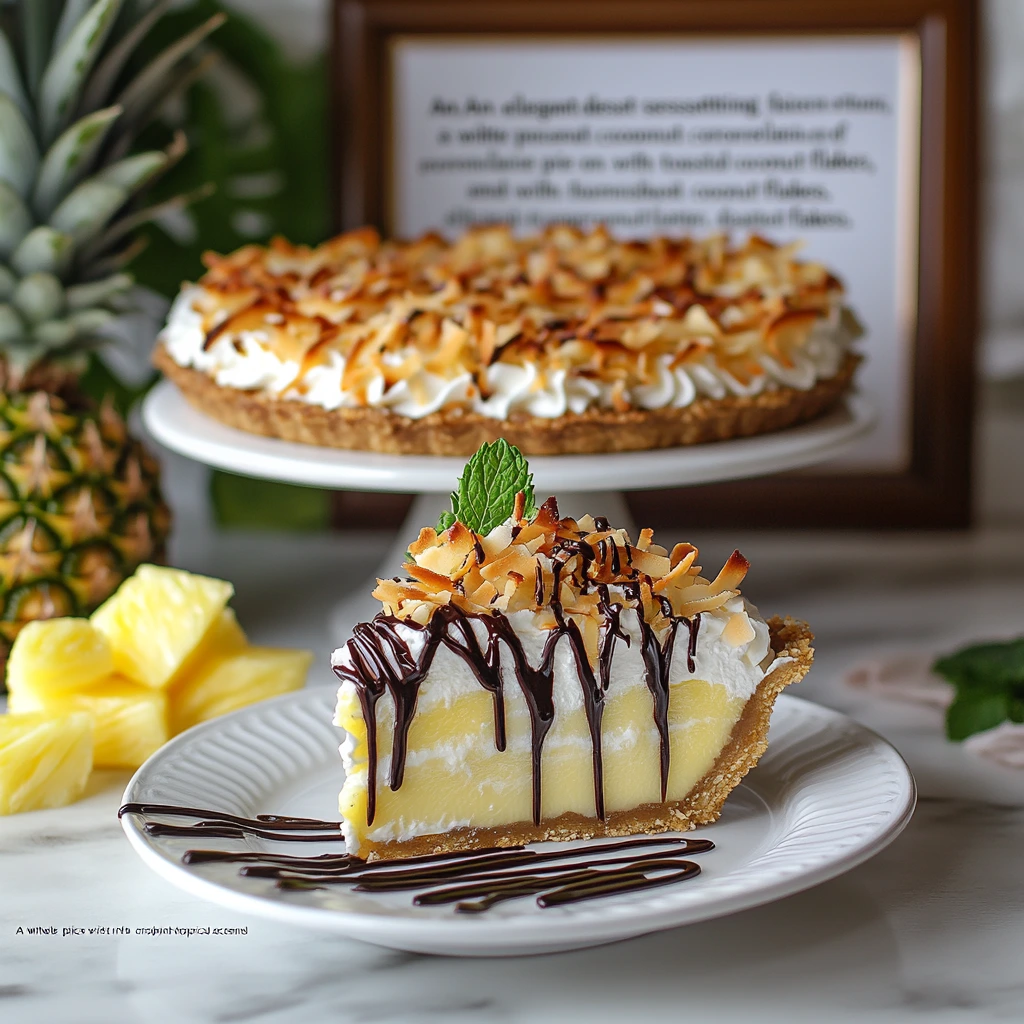Coconut Cream Pie Recipe is a classic dessert with roots tracing back to the 19th century, when coconut became a widely used ingredient in American kitchens due to increased trade with tropical regions. While its exact origin is uncertain, the pie has long been a favorite in Southern cuisine and has evolved into a staple dessert in diners and bakeries across the United States.
The charm of this homemade coconut custard pie lies in its layers of textures and flavors. From its buttery crust to the velvety coconut custard and airy topping, each bite is a delightful blend of sweetness and creaminess. Over the years, variations have emerged, incorporating regional twists like toasted coconut, pineapple, or even chocolate. Its popularity is further amplified by its adaptability, making it a star at holiday gatherings, summer barbecues, and everything in between.
Table of Contents
1. Ingredients List for an Easy Coconut Cream Pie Recipe

The success of a coconut cream pie depends on using fresh, high-quality ingredients. Here’s a list of essentials:
- Pie Crust: A flaky, buttery crust forms the base. You can opt for homemade or store-bought, depending on your preference.
- Coconut Custard: Made with whole milk, coconut milk, egg yolks, sugar, and cornstarch for thickening, this filling is rich and creamy.
- Sweetened Shredded Coconut: Adds texture and enhances the coconut flavor.
- Whipped Cream or Meringue: Toppings provide a light, airy contrast to the dense custard.
- Vanilla Extract: Balances the sweetness and adds depth to the flavor.
- Butter: Enriches the custard and enhances the crust’s flavor.
For the best results, use fresh shredded coconut, high-fat dairy, and pure vanilla extract.
2. Step-by-Step Guide to Making Coconut Cream Pie from Scratch
Step-by-Step Guide to Making Coconut Cream Pie Recipe
Mastering a coconut cream pie involves attention to detail at every step, from the crust to the custard and toppings. Follow this comprehensive guide for a flawless homemade pie.
1. Preparing the Pie Crust
Start with a homemade or store-bought crust. For homemade, mix flour, cold butter, salt, and water until the dough comes together, then roll it out and press it into a pie dish. Blind baking is essential to avoid a soggy crust. Use parchment paper and pie weights to keep the crust flat while baking. Bake at 375°F (190°C) for about 15 minutes with weights, then remove them and bake for an additional 10 minutes until golden brown. Allow the crust to cool completely.
2. Making the Coconut Custard
Combine whole milk, coconut milk, sugar, and cornstarch in a saucepan, whisking until smooth. Heat over medium, stirring constantly, until thickened. To prevent curdling, temper the eggs by whisking a bit of the hot mixture into the egg yolks before adding them back into the saucepan. Cook for a few minutes, then stir in shredded coconut, butter, and vanilla extract. Cool the custard before assembling.
3. Assembling the Pie
Spread the cooled custard into the baked crust, smoothing the surface. Chill the assembled pie for at least 4 hours to set properly. Add your choice of toppings, like whipped cream or meringue, just before serving for optimal texture and flavor.
This method ensures your coconut cream pie has a perfect crust, creamy filling, and a delightful topping for a dessert everyone will adore.
3. Delicious Topping Variations for Coconut Cream Pie Recipe
How to Make Whipped Cream for Homemade Coconut Cream Pie
A classic choice for coconut cream pie, whipped cream is light and easy to make:
- Chill a mixing bowl and beaters for 15 minutes.
- Beat 1 cup of heavy cream, 2 tablespoons of powdered sugar, and 1 teaspoon of vanilla extract until stiff peaks form.
- Spread or pipe the whipped cream over the pie, then garnish with toasted coconut.
Making Meringue for Traditional Coconut Custard Pie
For a more traditional topping:
- Beat 4 egg whites with 1/4 teaspoon of cream of tartar until soft peaks form.
- Gradually add 1/4 cup of sugar, beating until stiff peaks form.
- Spread the meringue over the custard, ensuring it touches the crust edges to seal. Bake at 375°F (190°C) for 10–12 minutes, or until golden brown.
4. Enhancements, Variations, and Serving Suggestions
Coconut cream pie is not only a classic dessert but also a versatile one, offering endless opportunities to customize and enhance. Here’s how you can take this pie to the next level while exploring related recipes and ideas.
1. Enhancements for the Perfect Coconut Cream Pie
To truly master the art of coconut cream pie, understanding the finer details is essential. For an in-depth guide to crafting the ideal meringue and other pro-level tips, visit “10 Secrets to the Perfect Coconut Cream Pie with Meringue”. This resource provides practical advice to help you achieve a perfectly golden and fluffy topping.

2. Creative Variations to Try
If you’re looking to experiment with traditional recipes, consider trying the “Betty Crocker Coconut Cream Pie with Meringue”. This variation stays true to classic flavors while offering a nostalgic touch that many will love.
For a fresh twist, explore tropical infusions like pineapple or chocolate, or even go vegan with dairy-free coconut milk and whipped topping. Each approach allows you to tailor the dessert to suit different tastes or dietary preferences.
3. Serving Suggestions and Related Desserts
Coconut cream pie pairs beautifully with tropical drinks or light desserts, but if you’re a fan of creamy indulgence, you might enjoy exploring other rich desserts like the “Philadelphia Pecan Pie Cheesecake”. This decadent recipe shares a similarly luscious texture and flavor profile, making it a great complement to your dessert table.
By integrating these enhancements, variations, and related recipes, you’ll not only elevate your coconut cream pie but also inspire yourself and your readers to explore more delightful treats!
5. How to Store Coconut Cream Pie Recipe for Freshness
How to Store Coconut Cream Pie for Freshness
Proper storage is crucial to maintaining the texture and flavor of coconut cream pie. Here’s a detailed guide to help you store your pie so it stays as fresh and delicious as when it was made.
1. Refrigerating Coconut Cream Pie
- Once assembled, coconut cream pie should always be stored in the refrigerator. The custard filling and whipped topping are perishable and require a cool environment to prevent spoilage.
- Cover the pie loosely with plastic wrap or foil to protect it from absorbing fridge odors and to keep the toppings intact. For added protection, use an airtight pie container.
- The pie can stay fresh in the refrigerator for up to 3 days. However, for the best flavor and texture, it’s recommended to consume it within 1–2 days.
2. Freezing Coconut Cream Pie
If you need to store the pie for longer, freezing is a viable option, but there are a few things to note:
- Freeze the pie before adding whipped cream or meringue topping, as these do not freeze well and may become watery upon thawing.
- Wrap the pie tightly in plastic wrap, ensuring all edges are sealed. Add a layer of aluminum foil for extra protection against freezer burn.
- Store the wrapped pie in the freezer for up to 1 month. To serve, thaw the pie in the refrigerator overnight, then add the topping just before serving.
3. Tips for Maintaining Freshness
- Avoid leaving the pie at room temperature for more than 2 hours, as this can cause the filling to spoil.
- Store leftover slices individually in airtight containers to preserve their structure and keep the crust from becoming soggy.
With these storage tips, you can ensure your coconut cream pie recipe retains its creamy texture and fresh taste for days to come.
6. Avoiding Common Mistakes When Making Coconut Cream Pie Recipe
- Soggy Pie Crust: To prevent a soggy bottom, always blind bake the crust before adding the custard. Use pie weights or dried beans to keep the crust from puffing up while baking, and allow it to cool completely before filling.
- Runny Custard: Achieving the right consistency is key to a successful coconut cream pie. Ensure you use the correct ratio of cornstarch to liquid, and cook the custard over medium heat while stirring constantly. It should thicken to the point where it coats the back of a spoon. Avoid overcooking, as this can cause the mixture to break or become grainy.
- Curdled Custard: When tempering egg yolks, add the hot milk mixture gradually while whisking to prevent the eggs from scrambling. Patience is key.
- Weeping Meringue: Spread meringue over warm custard to create a seal, ensuring it touches the edges of the crust. Bake until lightly golden to avoid moisture beads forming.
- Over-whipping Whipped Cream: For a whipped cream topping, beat the cream just until stiff peaks form. Over-whipping can result in a grainy texture.
By addressing these common challenges, you’ll ensure a flawless coconut cream pie every time.
7. Frequently Asked Questions About Coconut Cream Pie
Here are answers to common questions to help you troubleshoot and perfect your coconut cream pie:
1. Can I use coconut milk instead of whole milk in coconut cream pie?
Yes, coconut milk can replace whole milk for a richer, more coconut-forward flavor. Using full-fat coconut milk is ideal for maintaining the custard’s creamy texture. You can also use a combination of coconut milk and whole milk to balance the flavors and consistency.
2. How do I prevent meringue from weeping on my coconut cream pie?
Meringue weeping occurs when moisture beads form on the surface. To prevent this:
- Spread the meringue over the warm custard immediately after cooking. The heat helps seal the meringue to the filling.
- Ensure the meringue completely touches the crust edges to lock in moisture.
- Bake the meringue until lightly golden to stabilize it, and avoid refrigerating until it has cooled completely.
3. Can I make coconut cream pie in advance?
Yes, coconut cream pie can be made a day ahead. Prepare the crust and custard, then assemble and refrigerate. However, it’s best to add whipped cream or meringue toppings just before serving to maintain their freshness and texture.
4. How should I store coconut cream pie?
Refrigerate the pie in an airtight container or cover it loosely with plastic wrap to keep it fresh. Avoid storing it at room temperature for extended periods. For longer storage, freeze the pie (without the topping), and thaw in the refrigerator when ready to serve.
5. Can I freeze coconut cream pie?
Yes, coconut cream pie can be frozen, but for best results, freeze it without the whipped cream or meringue topping. Wrap it tightly in plastic wrap and foil to prevent freezer burn. Before serving, thaw the pie in the refrigerator overnight and add the topping fresh.
6. How can I fix runny custard?
If your custard is runny, it may not have been cooked long enough to thicken. For future attempts, ensure the custard reaches the correct thickness by cooking it over medium heat while stirring constantly. Using the right ratio of cornstarch or thickener is essential.
8. Conclusion: Mastering the Art of Coconut Cream Pie
coconut cream pie Recipe is a timeless dessert that combines simplicity with indulgence. By mastering the techniques for a flaky crust, creamy coconut custard, and the perfect topping, you can create a pie that will impress family and friends. Whether you stick to the classic recipe or explore creative variations like chocolate or pineapple-infused versions, this dessert offers endless possibilities to suit any occasion.
With its rich history, tropical flavor profile, and adaptable nature, coconut cream pie remains a crowd-pleasing favorite. Follow the tips and instructions in this guide, avoid common pitfalls, and experiment with toppings and garnishes to make it uniquely your own. From holidays to casual gatherings, your homemade coconut cream pie is sure to be a centerpiece dessert that everyone will enjoy!

